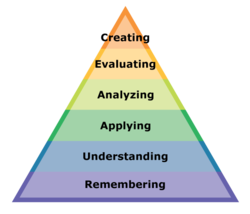What a Classroom Looks Like for Teachers and Students After Flipping
By guest blogger Swaroop Raju, co-founder of eduCanon
Flipping your classroom is not just about the videos. Often the discussion surrounding the flipped classroom centers on the technical aspect of video creation and video delivery, but in reality the flipped classroom revolves around the increased face-to-face time that it affords teachers to interact with their students.
By taking the lower level Bloom’s Taxonomy activities outside of class through video, podcasts, texts, or other medium, teachers are able to spend class time on higher-order activities.

So what are a some teachers doing with the increased class time they have, due to their flipped instruction? The examples below are taken from direct interviews with users of eduCanon.
1. Building a music video with students
Carolyn Daniels teaches middle school literature, science, and social studies at Our Lady of Mount Carmel School in Meriden, Connn. and is no stranger to the flipped classroom.
She flips her classroom so that she can spend more time connecting and working through activities with her students rather than just talking at them. Moreover, she finds that because her students are visual learners, watching a video is much more engaging than reading a textbook.
She recently built an eduCanon lesson out of a rap video explaining the scientific method. With the data that Daniels captured from eduCanon, she understood before class where student misconceptions lay and how to best group students for the next day’s lesson. In class she worked with her students on building their own scientific method rap video. Check out this scientific method rap video by Carolyn Daniels’ students.
The students not only watched a lesson, but also engaged the highest Bloom’s level—creating—as they built their own.
2. Working on problem sets
Lawrence Whisenant teaches AP physics at Arab High School in Arab, Ala. Although he loves working on problem sets with his students, he found during his first year of teaching that little time was left for hands-on activities. Rather, the majority of his class time was spent reviewing concepts and examples through traditional lectures.
Last year, Whisenant flipped his class for the first time so that he could work on problem sets with his students in class and get a better understanding of the concepts that challenge his students. Moreover, he wanted to make sure that he was with his students when questions arise so he could correct misconceptions in the moment.
He used the iPad recording app Explain Everything to deliver the basic concepts and introductory examples outside of class. In order to ensure his students watched the video, he embedded questions into the video lectures with eduCanon.
Whisenant said his lessons are now more student-centered. His students are more engaged and class time is now used exclusively for student understanding.
See also:
- What Are the Best Ways to Make a Flipped Classroom Work
- Take the Partnership Approach to Flipped Learning
- Is the Flipped Classroom Model Here to Stay?
For more on eduCanon follow us on Twitter at @educanon123.
